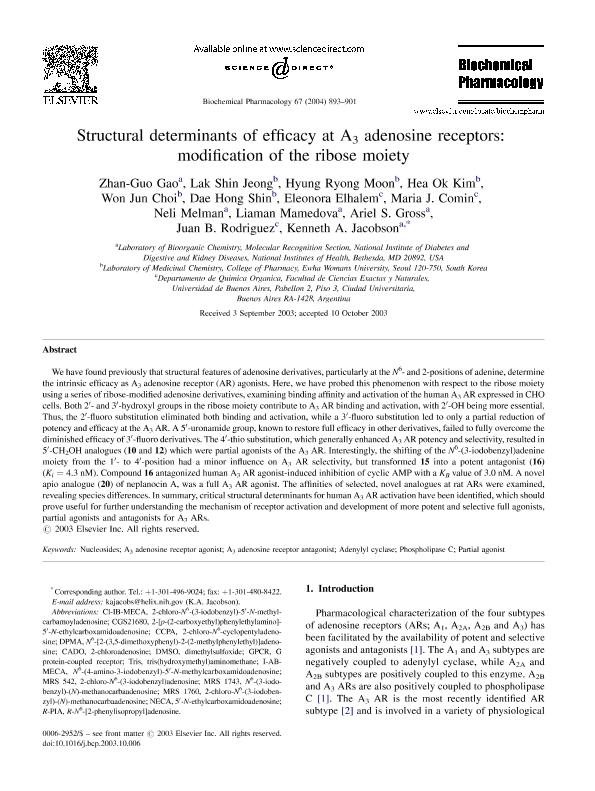Artículo
Structural determinants of efficacy at A3 adenosine receptors: Modification of the ribose moiety
Gao, Zhan-Guo; Jeong, Lak Shin; Moon, Hyung Ryong; Kim, Hea Ok; Choi, Won Jun; Shin, Dae Hong; Elhalem, Eleonora ; Comin, Maria Julieta
; Comin, Maria Julieta ; Melman, Neli; Mamedova, Liaman; Gross, Ariel S.; Rodriguez, Juan Bautista
; Melman, Neli; Mamedova, Liaman; Gross, Ariel S.; Rodriguez, Juan Bautista ; Jacobson, Kenneth A.
; Jacobson, Kenneth A.
 ; Comin, Maria Julieta
; Comin, Maria Julieta ; Melman, Neli; Mamedova, Liaman; Gross, Ariel S.; Rodriguez, Juan Bautista
; Melman, Neli; Mamedova, Liaman; Gross, Ariel S.; Rodriguez, Juan Bautista ; Jacobson, Kenneth A.
; Jacobson, Kenneth A.
Fecha de publicación:
03/2004
Editorial:
Pergamon-Elsevier Science Ltd
Revista:
Biochemical Pharmacology
ISSN:
0006-2952
Idioma:
Inglés
Tipo de recurso:
Artículo publicado
Clasificación temática:
Resumen
We have found previously that structural features of adenosine derivatives, particularly at the N6- and 2-positions of adenine, determine the intrinsic efficacy as A3 adenosine receptor (AR) agonists. Here, we have probed this phenomenon with respect to the ribose moiety using a series of ribose-modified adenosine derivatives, examining binding affinity and activation of the human A3 AR expressed in CHO cells. Both 2′- and 3′-hydroxyl groups in the ribose moiety contribute to A3 AR binding and activation, with 2′-OH being more essential. Thus, the 2′-fluoro substitution eliminated both binding and activation, while a 3′-fluoro substitution led to only a partial reduction of potency and efficacy at the A3 AR. A 5′-uronamide group, known to restore full efficacy in other derivatives, failed to fully overcome the diminished efficacy of 3′-fluoro derivatives. The 4′-thio substitution, which generally enhanced A3 AR potency and selectivity, resulted in 5′-CH2OH analogues (10 and 12) which were partial agonists of the A3 AR. Interestingly, the shifting of the N6-(3- iodobenzyl)adenine moiety from the 1′- to 4′-position had a minor influence on A3 AR selectivity, but transformed 15 into a potent antagonist (16) (Ki=4.3nM). Compound 16 antagonized human A 3 AR agonist-induced inhibition of cyclic AMP with a KB value of 3.0nM. A novel apio analogue (20) of neplanocin A, was a full A 3 AR agonist. The affinities of selected, novel analogues at rat ARs were examined, revealing species differences. In summary, critical structural determinants for human A3 AR activation have been identified, which should prove useful for further understanding the mechanism of receptor activation and development of more potent and selective full agonists, partial agonists and antagonists for A3 ARs.
Archivos asociados
Licencia
Identificadores
Colecciones
Articulos(UMYMFOR)
Articulos de UNID.MICROANAL.Y MET.FISICOS EN QUIM.ORG.(I)
Articulos de UNID.MICROANAL.Y MET.FISICOS EN QUIM.ORG.(I)
Citación
Gao, Zhan-Guo; Jeong, Lak Shin; Moon, Hyung Ryong; Kim, Hea Ok; Choi, Won Jun; et al.; Structural determinants of efficacy at A3 adenosine receptors: Modification of the ribose moiety; Pergamon-Elsevier Science Ltd; Biochemical Pharmacology; 67; 5; 3-2004; 893-901
Compartir
Altmétricas



